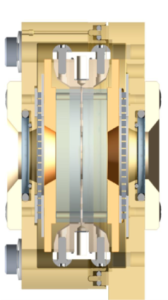Extension of the SODI instrument for Neuf-Dix (Non-EquilibriUm Fluctuations during DIffusion in compleX liquids)
Programme
GSTP
Programme Reference
G612-005MM
Prime Contractor
QINETIQ SPACE NV
Start Date
End Date
Status
Closed
Country
Belgium

Objectives
Design and breadboarding of a fluid cell array for shadowgraphy diagnostics of SODI (Selectable Optical Diagnostic Instrument) for the detection of non-equilibrium fluctuations during diffusion in complex liquids.
Description
Currently an instrument called SODI (Selectable Optical Diagnostic Instrument) is available for diffusion experiments in fluids on the ISS. It has allowed to conduct many more experiments than originally planned in the fields of DCMIX (diffusion and Soret coefficient measurements), IVIDIL (investigations on induced vibrations on diffusion in liquids) and COLLOID (colloidal agglomerations in fluids) since its start of operation in 2008 and therefore proved quite reliable. The new group of Neuf-Dix (Non-EquilibriUm Fluctuations during DIffusion in compleX liquids) experiments will take advantage of this heritage by reusing as much of the hardware of SODI as possible. While SODI provides a set of optical diagnostic instruments,namely Mach-Zender Interferometry, Digital Holographic Microscopy and Near-Filed Light Scattering and uses optical fluid cells with thermal control, it requires the addition of a shadowgraph system and new optical fluid cells where the temperature gradient is generated along the optical axis. The IPU (Image Processing Unit), the operation computer and data storage unit as well as electronic subunits are considered to be reusable for Neuf-Dix. While first evaluations of reuse have been performed by the scientific user community, a more detailed analysis needs to be performed at the beginning of this activity with the goal of maximum reusability and interchangeability of components such as the IPU.
This GSTP activity will focus on the development of the optical fluid cells.
In this activity the technical challenges will be the precision of the thermal control, the optical quality of the cell windows and the proper containment and sealing of the fluid in the cell.
In particular, the following tasks are foreseen in the frame of this activity:
- Requirements consolidation, including the Science Community (SC).
- Conceptual Design development.
- Detailed Design including some testing and bread boarding.
Application Domain
Space Science
Technology Domain
14 - Life & Physical Sciences
Competence Domain
6-Life & Physical Science Payloads, Life Support, Robotics & Automation
Initial TRL
TRL 2
Target TRL
TRL 4
Achieved TRL
TRL 4
Public Document
Executive Summary
